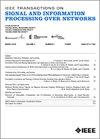BDoG-Net:图上的盲反卷积算法展开
IF 3
3区 计算机科学
Q2 ENGINEERING, ELECTRICAL & ELECTRONIC
IEEE Transactions on Signal and Information Processing over Networks
Pub Date : 2025-09-11
DOI:10.1109/TSIPN.2025.3608959
引用次数: 0
摘要
从第一图信号处理(GSP)原理出发,提出了一种新的基于模型的深度学习方法来实现稀疏图信号的盲反卷积。尽管观测值具有双线性性质,但通过要求未知(扩散图滤波器)正演算子的可逆性,我们可以制定一个凸优化问题,并使用乘法器的交替方向方法(ADMM)来解决它。然后,我们展开并截断新的ADMM迭代,以获得用于图上盲反卷积的参数化神经网络架构(BDoG-Net),我们使用标记数据以端到端方式进行训练。这种监督学习方法具有可解释性、参数效率和推理过程中可控制的复杂性等优点。我们可重复的数值实验证实,BDoG-Net的性能与迭代ADMM基线相当,但推理时间明显更快,而且不需要手动调整步长或惩罚参数。本文还讨论了BDoG-Net在网络源定位的一个简化实例中的应用。总的来说,我们的方法结合了两个世界的优点,将基于GSP模型的解决方案的归纳偏差纳入数据驱动的、可训练的深度学习架构中,用于图上的盲反卷积。本文章由计算机程序翻译,如有差异,请以英文原文为准。
BDoG-Net: Algorithm Unrolling for Blind Deconvolution on Graphs
Starting from first graph signal processing (GSP) principles, we present a novel model-based deep learning approach to blind deconvolution of sparse graph signals. Despite the bilinear nature of the observations, by requiring invertibility of the unknown (diffusion graph filter) forward operator we can formulate a convex optimization problem and solve it using the alternating-direction method of multipliers (ADMM). We then unroll and truncate the novel ADMM iterations to arrive at a parameterized neural network architecture for blind deconvolution on graphs (BDoG-Net), which we train in an end-to-end fashion using labeled data. This supervised learning approach offers several advantages, such as interpretability, parameter efficiency, and controllable complexity during inference. Our reproducible numerical experiments corroborate that BDoG-Net exhibits performance on par with the iterative ADMM baseline, but with markedly faster inference times and without the need to manually adjust the step-size or penalty parameters. The application of BDoG-Net to a simplified instance of source localization over networks is also discussed. Overall, our approach combines the best of both worlds by incorporating the inductive biases of a GSP model-based solution within a data-driven, trainable deep learning architecture for blind deconvolution on graphs.
求助全文
通过发布文献求助,成功后即可免费获取论文全文。
去求助
来源期刊

IEEE Transactions on Signal and Information Processing over Networks
Computer Science-Computer Networks and Communications
CiteScore
5.80
自引率
12.50%
发文量
56
期刊介绍:
The IEEE Transactions on Signal and Information Processing over Networks publishes high-quality papers that extend the classical notions of processing of signals defined over vector spaces (e.g. time and space) to processing of signals and information (data) defined over networks, potentially dynamically varying. In signal processing over networks, the topology of the network may define structural relationships in the data, or may constrain processing of the data. Topics include distributed algorithms for filtering, detection, estimation, adaptation and learning, model selection, data fusion, and diffusion or evolution of information over such networks, and applications of distributed signal processing.
 求助内容:
求助内容: 应助结果提醒方式:
应助结果提醒方式:


